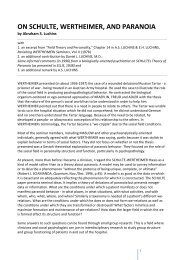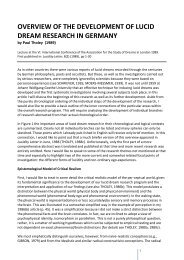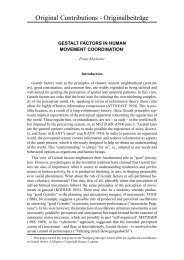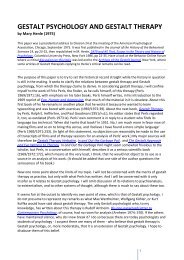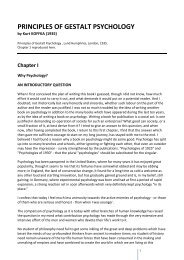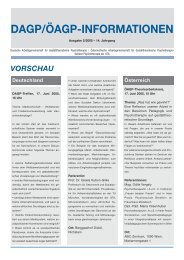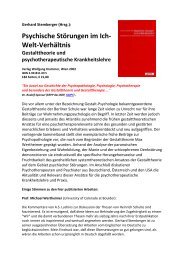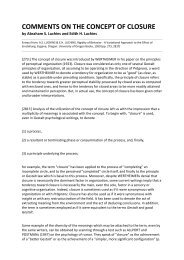pdf-Download - Society for Gestalt Theory and its Applications (GTA)
pdf-Download - Society for Gestalt Theory and its Applications (GTA)
pdf-Download - Society for Gestalt Theory and its Applications (GTA)
Create successful ePaper yourself
Turn your PDF publications into a flip-book with our unique Google optimized e-Paper software.
<strong>for</strong> Turkey raised the problem of who was to be his replacement during HEMPELs defense of his<br />
thesis. Wolfgang KÖHLER stepped in to take REICHENBACHs place, as was the case in Olaf<br />
HELMERs defense; psychology <strong>and</strong> philosophy (<strong>and</strong> physics) were in the same faculty. Although<br />
HEMPEL was of "Aryan" stock, he manifested so-called Philosemitism, "an offense [in Nazi<br />
Germany] against which his father <strong>and</strong> other well-wishers had warned him more than once" (pp.<br />
147-148).[18] His wife, Eva AHRENDS, had inherited "Jewish blood" from her father, as had been<br />
the case with his mentor. [Eva died in 1944 shortly after giving birth to their first child, Peter<br />
Andrew. Two years later HEMPEL married Diane PERLOW, who is Jewish.]<br />
Germany in 1934 was "uninhabitable" <strong>for</strong> Peter <strong>and</strong> Eva HEMPEL. They went to Brussels, Belgium,<br />
where he collaborated with OPPENHEIM. [REICHENBACH may have provided the link to<br />
OPPENHEIM who was interested in logical empiricism.] The OPPENHEIMS supported the HEMPELS,<br />
or better, "made it possible <strong>for</strong> them to support themselves" (p. 147).[18]<br />
In 1937 the HEMPELS came to the United States <strong>and</strong> moved to Chicago where Rudolf CARNAP had<br />
obtained ROCKEFELLER research fellowships <strong>for</strong> HEMPEL <strong>and</strong> also <strong>for</strong> his friend <strong>and</strong> collaborator,<br />
Olaf HELMER, who also collaborated with OPPENHEIM. In 1939/1940, HEMPEL taught summer <strong>and</strong><br />
evening classes at City College, New York. From 1940 to 1948 he taught at Queens College in New<br />
York, first as instructor <strong>and</strong> then as assistant professor. Then he became associate professor in the<br />
Philosophy Department of Yale University where he remained until 1955 when he accepted<br />
Princeton University's invitation to be Stuart Professor of Philosophy, a position he held until his<br />
m<strong>and</strong>atory retirement in 1973, after which he continued to teach as a lecturer. He became<br />
University Professor of Philosophy in 1977 in the University of Pittsburgh, retiring again in 1985,<br />
when he returned to Princeton, "his adoptive home," where he continued his philosophical work<br />
<strong>for</strong> another decade. Among his many honors were ten honorary degrees, including one from<br />
Princeton University. Like OPPENHEIM, HEMPEL "welcomed opportunities <strong>for</strong> kindness,<br />
generosity, courtesy" (p. 149). HEMPEL died in a nursing home near Princeton on 9 November<br />
1997, at 92 years of age. He is survived by his wife, by his son, <strong>and</strong> by his daughter, Mir<strong>and</strong>a<br />
Tobyanne HEMPEL, as well as by two gr<strong>and</strong>daughters.<br />
The obituary in the New York Times focused on HEMPELs empirical approach <strong>and</strong> the central role<br />
it played in philosophy of science in America.18a<br />
The Final Years of Kurt GRELLING<br />
First a brief overview to bring us to the final years:<br />
When Carl Gustav [Peter] HEMPEL went to the United States, Kurt GRELLING left Berlin to come to<br />
Brussels in 1937 <strong>and</strong> again in 1938 to take his place working with Paul OPPENHEIM. When an<br />
apparent opportunity arose to return to his "beloved fatherl<strong>and</strong>," instead of undertaking<br />
emigration "at r<strong>and</strong>om," GRELLING gave it some thought, as he wrote to Otto NEURATH in January<br />
1938. This hesitation might have slowed down the attempts to help him come to the U.S.A.<br />
However, after the Kristallnacht (9/10 November 1938), GRELLING did not set foot on German<br />
soil.<br />
It was planned that the HEMPELs (Peter <strong>and</strong> his first wife Eva), on arrival in the U.S.A. in 1937,<br />
would help find employment <strong>for</strong> GRELLING here, later aided by the OPPENHEIMs (Paul <strong>and</strong><br />
Gabrielle), who had come to the U.S.A. in 1939, <strong>and</strong> settled in Princeton, New Jersey. The<br />
OPPENHEIMS <strong>and</strong> the HEMPELS spearheaded the ef<strong>for</strong>ts to rescue GRELLING by securing an<br />
13



